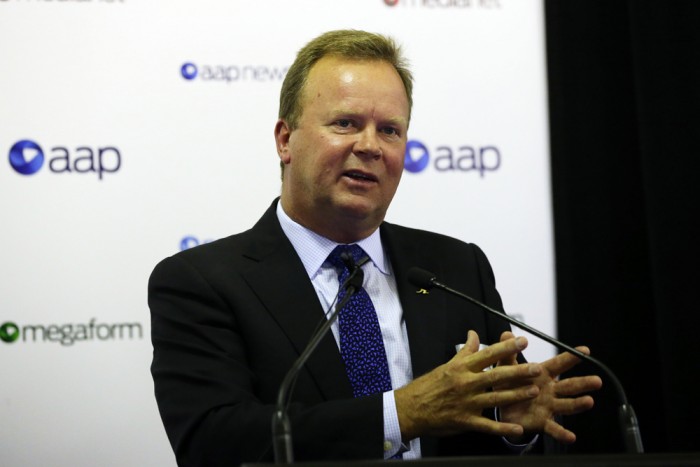Pulver on the future of women’s rugby
Bill Pulver is best known as the CEO of the Australian Rugby Union, but he is also chairman of World Rugby’s Women’s Advisory Committee and so has a key role in the development of the women's game. Last week, at the World Rugby Conference, he spoke about his hopes and plans for the development of women’s rugby, and why it is so important for the future of rugby as a whole
Published by John Birch, November 20th, 2016
7 minute read

The questions began by asking Bill how big has the women’s game has become in Australia since the Olympics.
“Well, we are extremely proud of our Aussie women’s team. They are wonderful athletes and ambassadors for the game and having had a three-year programme [up to 2013] we put them into a professional programme in Sydney alongside the men’s sevens team, and having the outcome of a gold medal at the Olympics was phenomenal
“When they got back to Australia they were met by young girls all around the country. They were rock stars!
“I believe that the growth of the women’s game should be central to every country’s development plan. There is actually a land grab for elite women’s sporting talent. In Australia we’ve got cricket and rugby league and Australian Rules and soccer...
“All these sports are desperate to get their hands on the elite female talent. Now rugby is a better game than all of them. Played well it is a better game to watch and participate in, which is an advantage for us, but it’s important to realise that there is this landgrab going on and to see the pursuit of elite female talent.
“To deliver the outcomes we want, correcting the role of women in our game is more than just on the field. What we have to do is normalise the role of women in the game. That starts at the boardroom and all the way to the playing field. We need a lot more female involvement at all levels, but we have a lot of work to do normalise the role of women and when we do the benefits I think will be huge. Women will spend the same $1000 a year that men spend on the game. Not only will it be a performance engine but an economic engine for the game as well.”
So, do you think thatwould bethe argument to unions who may not have money to spend on all aspects of the game?
“There is an enormous economic reality. I come from a country where sports governing bodies are all scrabbling to make the finances add up. So, there is always a fight for the hearts and minds of children. We want to see the growth in our revenue so we have to invest in participation opportunities. I can tell you that the growth of women in the game is probably the single biggest opportunity to grow revenue, and that will help solve a lot of the problems for a lot of national unions.”
Where should future development should be targeted?
“I think World Rugby has done a wonderful job at the elite end of the women’s game. We’ve got a World Cup in Ireland next year and women’s 7s at the Olympics. But I now think the vision needs to go down through the ranks to individual country level. In Australia, next year we will launch a national women’s sevens series. That’s just to connect the dots on the national pathway. You’ve got to go down to how you capture the hearts and minds of young 8-11-year-old girls. And that is going to be the most challenging issue because there is still going to be this image of the physicality of rugby. A lot of mums won’t let their boys play the game because they are worried about the physicality of the game so they’ll be even more worried about their young daughters playing.
“So, we’ll be looking at a strategy at that very young age of non-contact sevens. Now anyone who has played touch football will know what fun it is. Touch teaches you the skills of the game. We’ve launch the Viva sevens – a non-contact version of the game. Once they enjoy and get a love for the game and learn the values of the game then they’re on the pathway. Some may prefer to stay with the non-contact version of the game, but a lot will graduate to tackle 7s and 15s. So, all credit to World Rugby about what it has achieved but now we have down to the grass roots of the game.”
Fifteens rugby is a unique game for all shapes and sizes, but that is not true of sevens. How can we continue to develop fifteens when sevens has such a high profile?
“I would suggest it is the greatest dilemma we have as a code. I can only answer for Australia where we are resource constrained. And inherent is the fact that rugby is a game for all shapes and sizes so what we don’t want is to gravitate to sevens and stop a lot of women playing the game, and we have to walk this balance and I give WR great credit because they clearly have a commitment to a WRWC at the pinnacle of the game means countries like mine continue to invest. The challenge is juggling the financial investment between 7s and 15s when certainly in Australia there has been a slight long term decline in the number of 15s players and a meteoric growth in the number of 7s players but we are following the lead of WR and I think it’s important we continue to invest in the 15s game. I don’t think it will be the same level as the 7s. But the investment will be there to ensure that women of all shapes and sizes can play the game.”